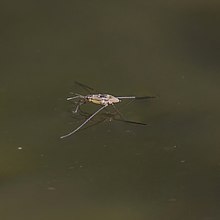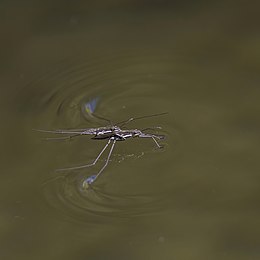| Gerridae Temporal range:
| |
|---|---|
| Mating in Cyprus | |
| Scientific classification | |
| Domain: | Eukaryota |
| Kingdom: | Animalia |
| Phylum: | Arthropoda |
| Class: | Insecta |
| Order: | Hemiptera |
| Suborder: | Heteroptera |
| Superfamily: | Gerroidea |
| Family: | Gerridae Leach, 1815 |
| Subfamilies[1] | |


The Gerridae are a family of insects in the order Hemiptera, commonly known as water striders, water skeeters, water scooters, water bugs, pond skaters, water skippers, water gliders, water skimmers or puddle flies. Consistent with the classification of the Gerridae as true bugs (i.e., suborder Heteroptera), gerrids have mouthparts evolved for piercing and sucking, and distinguish themselves by having the unusual ability to walk on water, making them pleuston (surface-living) animals. They are anatomically built to transfer their weight to be able to run on top of the water's surface. As a result, one could likely find water striders present in any pond, river, or lake. Over 1,700 species of gerrids have been described, 10% of them being marine.[2]
While 90% of the Gerridae are freshwater bugs, the oceanic Halobates makes the family quite exceptional among insects. The genus Halobates was first heavily studied between 1822 and 1883 when Francis Buchanan White collected several different species during the Challenger Expedition.[3] Around this time, Eschscholtz discovered three species of the Gerridae, bringing attention to the species, though little of their biology was known.[3] Since then, the Gerridae have been continuously studied due to their ability to walk on water and unique social characteristics.
- ^ Schuh R.T., Slater J.A. (1995). True Bugs of the World (Hemiptera: Heteroptera). Classification and Natural History. Cornell University Press, Ithaca, New York, USA. 336 pp.
- ^ Lancaster, J.B.; Briers, R., eds. (2008). Aquatic insects: challenges to populations. CABI. pp. 23, 270, 284.
- ^ a b Cheng, L. (1985). "Biology of Halobates (Heteroptera: Gerridae)". Annual Review of Entomology. 30 (1): 111–135. doi:10.1146/annurev.en.30.010185.000551. S2CID 86774669.
